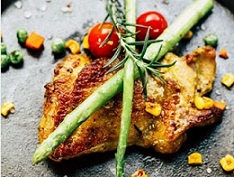
With websites and applications like Pinterest, Allrecipes, Tasty and Epicurious, it’s hard to resist attempting the featured mouth watering creations.
No matter how simple the instruction, cooking anything can be intimidating to those of us who are not experienced. Chicken is one of the most commonly consumed protein options for most Canadians, but are we doing this right? There are many different options when it comes to preparing your chicken, various cooking methods and depending on the specific cut you are using; the temperature guideline can differ. Chicken is our go to protein, with the unlimited possibilities and pairing options, it is difficult to grow tired of the changing flavours and endless uses.
Chicken is one of the most commonly consumed protein options for most Canadians, but are we doing this right?
Firstly there are many different cooking methods that we must first become familiar with:
- Braise: Meat is seared, or browned in fat, and then simmered in liquid on low heat in a covered pot on the stovetop or in the oven for a long time.
- Broil: Meat is cooked directly under or above a heat source in an oven directly under the gas or electric heat source, or on a barbecue grill directly over charcoal or other heat source.
- Deep Fry: Meat is submerged in very hot oil in a deep-fryer or pot on the stovetop.
- Grill: Meat is cooked over hot coals or other heat source; often referred to as barbecuing.
- Pan Fry: Meat is quick-cooked in a small amount of hot oil. Preserves the flavor of the meat and lends a nice brown color.
- Roast: Meat is cooked in the oven in an uncovered pan, a method that usually produces a well-browned exterior and moist interior.
- Stew: Meat is barely covered with liquid and simmered slowly for a long time in a tightly covered pot. Blends flavors deliciously.
| Cut/Method | Braise | Broil | Deep Fry | Grill | Pan Fry | Roast | Stew |
| Boneless Breast | x | x | x | x | x | ||
| Bone in Breast | x | x | x | x | x | x | x |
| Drumsticks | x | x | x | x | x | x | |
| Whole Leg quarter | x | x | x | x | x | x | |
| Bone in Thigh | x | x | x | x | x | x | |
| Whole chicken | x | x | |||||
| Wings | x | x | x | x | x |
Secondly, how do you know when your chicken is cooked enough to consume? Here are a few tips to follow when checking to see if your chicken has reached the necessary safe internal cooking temperature:
- Remove your food from the heat and insert the digital food thermometer through the thickest part of the meat, all the way to the middle, but do not touch the bone.
- Make sure that the thermometer is not touching any bones, since they heat up more quickly than the meat and could give you a false reading.
- If you have more than one piece of meat, be sure to check each piece separately, as temperatures may differ in each piece
- If the proper temperature is not reached, the chicken should be returned to the heat source for further cooking.
| Chicken cut | Internal Temperature |
| Chicken Breast and Wings | 175° - 180° |
| Chicken Dark Meat | 180° |
| Ground Chicken | 170° |
| Whole Chicken - Thigh area | 175° - 180° |
| Whole Chicken - Breast area | 170° - 175° |
| Stuffing inside Whole Chicken | 165° |
The part of the chicken meat to probe for proper temperature:
- Whole chicken, unstuffed: Insert a meat thermometer into the thickest part of the thigh, but not near bone or fat. Done when reading is 180-185°F.
- Whole chicken, stuffed:
Insert meat thermometer into the center of the body cavity. Done when stuffing registers 165°F.
(Note: Chicken should be stuffed just before roasting. Never stuff a chicken ahead of time.) - Whole chicken breasts:
Done when meat thermometer reading is at least 170°F.
The breast is one of the most popular parts of the chicken to eat because it’s both an excellent source of protein and low in fat.
However, there’s nothing worse than eating a dried-out piece of chicken, so the key is to keep it moist.
Since chicken breasts found in grocery stores tend to be quite large, it can make them difficult to cook through, without drying them out.
To ensure your chicken cooks evenly and stays nice and juicy, try pounding the breast out with a rolling pin or mallet until it’s slightly flattened.
If you’re grilling or pan-frying, you get the best results when you cook the breast at a high temperature for a short amount of time. - Chicken pieces, bone-in:
For smaller bone in cuts, like a chicken thigh. insert a fork in the chicken.
It should go in easily and juices should run clear. However, the meat and juices nearest the bones might still be a little pink even though the chicken is cooked thoroughly.
The temperature of these cuts should be 180°F minimum. One of the most beloved parts of the chicken is the wing.
The skin on the outside gets nice and crispy, keeping the moisture in the meat, while the bones on the inside give it a rich, meaty flavour.
So, no matter what you do with this part of the chicken, it’s bound to taste good. - Chicken pieces, boneless:
Cut into chicken with a knife. Done when center is no longer pink.
The thigh is often considered the tastiest part of the bird because it has a higher fat content, resulting in a more flavourful cut of meat.
It’s also a more economical alternative to buying chicken breasts, so feel free to experiment using thigh meat instead of breast meat — just substitute two thighs for every breast used in a recipe.
No matter your level of expertise or cooking knowledge, these guidelines should help you ensure that you are serving the best chicken, regardless of the cooking method.
Try one of the delicious chicken recipes featured on the Cericola Pinterest page today. Happy eating!
Cericola Recommendations:
Whole Chicken - Roast it! The secret to a delicious chicken is buying the best quality bird you can find, such as a locally raised one from a small farm. All Cericola chickens are raised by local farmers.
For an extra-crisp and golden skin, pat chicken dry with paper towel and leave in the fridge (unwrapped) on a baking sheet overnight.

